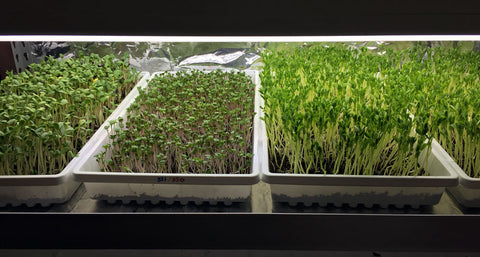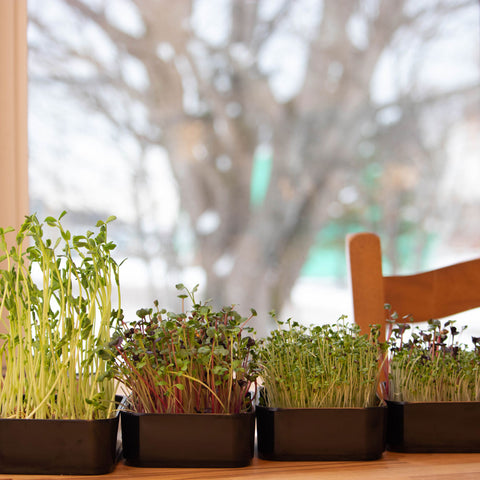origin story
Some years ago during the depths of a Canadian winter Max started growing microgreens at home in an attempt to provide something fresh, healthy and affordable for his family.
After doing a bit of research, he set up a grow unit in his basement comprised of:
- One 2’x4' utility shelving unit with 5 shelves, 1 shelf for germinating in the dark, 3 shelves with lights for growing and the bottom shelf for storage
- Six 4' fluorescent shop lights with 6500k daylight bulbs (2 lights per shelf)
- Sixteen 10"x20" black grow trays with no drainage holes (4 trays per shelf)
With this small investment and a bit of practice, he was able to grow almost a kilo of nutritious microgreens each week — more than enough to provide fresh, healthy and affordable greens to his family.

One shelf from Max's original grow unit.

One shelf of Max's fridge.
That Spring and Summer, Max and his father Alan sowed the seeds of what would grow into The Micro Farmers of today.
They started by growing microgreens for local farm markets and CSAs but within a year the problems with this model became apparent: waste, cost and access.
As you might imagine, delicate microgreens don’t do well on store shelves after having been put through the wringer of commercial food production and distribution. This leads to waste, drives up cost and limits where microgreens can be sold. The result: pre-grown microgreens in stores are generally too expensive and hard to find for most people to incorporate into their everyday lives.
Alan & Max would need a new plan if they really wanted to get microgreens into everyone’s hands.
They soon realized that the solution was for people to simply grow microgreens at home. A counter-intuitive solution given societal trends but they believed that if they made it easy and convenient enough, people would fall in love with the process and results.

So, they created simple, high quality grow kits that made it easy and affordable for people to grow microgreens with just a windowsill and clean water.
Along the way they learned that growing food is empowering and therapeutic. It enriches what people believe they can do for themselves and their loved ones and it reconnects them to food in a way that nothing else can.
